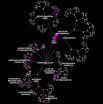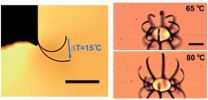(Press-News.org) New research led by Plymouth University Peninsula Schools of Medicine and Dentistry suggests that the cognitive test used in Alzheimer's drug trials is flawed.
The current standard cognitive test for the disease is the ADAS Cog. The new research, published as two studies in Alzheimer's & Dementia: The Journal of the Alzheimer's Association, investigates the role of the test and questions its effectiveness.
The studies show that the ADAS Cog is not subtle enough to properly track changes in the early stages of Alzheimer's. This is important because data from this key stage is required to show whether or not a new drug is working. The study also showed that the modern method of "Rasch analysis" confirmed the flaw.
In their first study, the researchers examined 675 measurements from people, aged 53 to 90, with mild Alzheimer's disease across five time points – 0, six, 12, 18 and 24 months. In terms of final patient score the ADAS-cog seemed sound. But by breaking down all the data to component level, a different story emerged. A "ceiling effect" was exposed for eight out of the 11 parts of the ADAS-cog with many patients – ranging from 32 to 83 per cent - "passing" the section when in reality much greater variance between the patients almost certainly existed and needed scoring.
In the second study, the research team moved on to use the modern method of "Rasch analysis" to further test the data. This confirmed the flaw. The more sophisticated method of analysis also suggested a number of possible pathways to improvement including making parts of the ADAS-cog test more difficult as well as re-thinking the scoring structure.
As a consequence, the Plymouth-based research team is suggesting urgent changes to the ADAS Cog – and is not ruling out the need for a new test.
The study was led by Professor Jeremy Hobart. He said: "It is impossible to say precisely the extent to which the ADAS Cog's flaws have undermined the numerous clinical trials in which it has been used. It has been used, unchanged, for many years and its apparent contribution to suboptimal trials has led a number of drug companies to rethink their strategies. However, it is very clear that in its current form the ADAS Cog underestimates cognitive differences between people and changes over time. To determine if treatments, developed from painstaking years of research, work in expensive studies we need to invest in developing measurement instruments that are fit for purpose. This requires the routine use of different methods. In its current form, the ADAS Cog is not working in people with mild Alzheimer's disease."
###
Notes to Editors
The Alzheimer's Disease Assessment Scale Cognitive Behaviour Section (ADAS Cog) was developed in the 1980s. It has 11 component parts including memory tests, language skills, naming objects and responding to commands. Patients get a score for each section resulting in a single overall figure. A low total score signals better cognitive performance.
The exposure of the limitations of the ADAS Cog comes as leading pharmaceutical companies are widely reported to be rethinking their strategy over new Alzheimer's treatments. For example: Pfizer and Johnson & Johnson halted the development of the drug Bapineuzumab after it did not work in clinical trials using the ADAS Cog; and Eli Lilly said its Alzheimer's drug solanezumab "failed in its main goal of halting progress of the disease" – the trials had used the ADAS Cog.
Alzheimer's disease is the most common form of dementia, affecting some 27 million people worldwide with incidence rates expected to quadruple by 2050.
Flaw in Alzheimer's drug trial test
2012-12-17
ELSE PRESS RELEASES FROM THIS DATE:
Worries about dementia how hospitalization affects the elderly
2012-12-17
Older people often worry about dementia and while some risks are known, for example alcoholism or stroke, the effects of illness are less clear. New research published in BioMed Central's open access journal Critical Care looks at illness requiring hospitalization and treatment in the intensive care unit (ICU) and finds that infection or severe sepsis, neurological dysfunction, such as delirium, or acute dialysis are all independently associated with an increased risk of a subsequent diagnosis of dementia.
This study was based on a random 5% of older (66 years or above) ...
Do-it-yourself viruses: How viruses self assemble
2012-12-17
A new model of the how the protein coat (capsid) of viruses assembles, published in BioMed Central's open access journal BMC Biophysics, shows that the construction of intermediate structures prior to final capsid production (hierarchical assembly) can be more efficient than constructing the capsid protein by protein (direct assembly). The capsid enveloping a virus is essential for protection and propagation of the viral genome. Many viruses have evolved a self-assembly method which is so successful that the viral capsid can self assemble even when removed from its host ...
Toward a new model of the cell
2012-12-17
Turning vast amounts of genomic data into meaningful information about the cell is the great challenge of bioinformatics, with major implications for human biology and medicine. Researchers at the University of California, San Diego School of Medicine and colleagues have proposed a new method that creates a computational model of the cell from large networks of gene and protein interactions, discovering how genes and proteins connect to form higher-level cellular machinery.
The findings are published in the December 16 advance online publication of Nature Biotechnology.
"Our ...
Penn Study shows resistance to cocaine addiction may be passed down from father to son
2012-12-17
PHILADELPHIA – Research from the Perelman School of Medicine at the University of Pennsylvania and Massachusetts General Hospital (MGH) reveals that sons of male rats exposed to cocaine are resistant to the rewarding effects of the drug, suggesting that cocaine-induced changes in physiology are passed down from father to son. The findings are published in the latest edition of Nature Neuroscience.
"We know that genetic factors contribute significantly to the risk of cocaine abuse, but the potential role of epigenetic influences – how the expression of certain genes related ...
Snack attack: Eating unhealthy snack foods may affect cancer risk in patients with Lynch syndrome
2012-12-17
A new analysis has found that loading up on snack foods may increase cancer risk in individuals with an inborn susceptibility to colorectal and other cancers. Published early online in CANCER, a peer-reviewed journal of the American Cancer Society, the study suggests that an eating pattern low in snack foods could help these individuals—who have a condition called Lynch syndrome—lower their risk.
Lynch syndrome is an inherited condition characterized by a high risk of developing colorectal cancer, endometrial cancer, and other cancers at an early age. The syndrome is ...
Student-athletes could lose eligibility, scholarships with tweet missteps, Baylor research shows
2012-12-17
With a single social-media misstep, student-athletes could lose athletic eligibility or a scholarship. But that's not stopping them from using Twitter – sometimes even during games, when they may see harsh criticism of their performances from fans, according to a study by Baylor University and Clemson University researchers.
While many college athletic teams prohibit student-athletes from using social media during games, some breach the rules to get a "real-time" commentary on how they are doing during the game, said Blair Browning, Ph.D., an assistant professor of communication ...
Why are kids in asthma hotspots in NYC more likely to visit the ER? Exercise may be a factor
2012-12-17
Asthmatic children in New York City neighborhoods with high rates of asthma make many more visits to the emergency room (ER) than those who live in other parts of the city. While socioeconomic factors such as lack of adequate preventive care are part of the equation (high-asthma neighborhoods tend to be lower income), new research points to a possible biological basis for the disparity. Asthmatic children living in asthma hotspots were twice as likely to experience a common symptom known as exercise-induced wheeze than were those in neighborhoods with lower asthma rates. ...
Math formula gives new glimpse into the magical mind of Ramanujan
2012-12-17
December 22 marks the 125th anniversary of the birth of Srinivasa Ramanujan, an Indian mathematician renowned for somehow intuiting extraordinary numerical patterns and connections without the use of proofs or modern mathematical tools. A devout Hindu, Ramanujan said that his findings were divine, revealed to him in dreams by the goddess Namagiri.
"I wanted to do something special, in the spirit of Ramanujan, to mark the anniversary," says Emory mathematician Ken Ono. "It's fascinating to me to explore his writings and imagine how his brain may have worked. It's like ...
Greed, not generosity, more likely to be 'paid forward'
2012-12-17
WASHINGTON — Paying it forward - a popular expression for extending generosity to others after someone has been generous to you - is a heartwarming concept, but it is less common than repaying greed with greed, according to new research published by the American Psychological Association.
"The idea of paying it forward is this cascade of goodwill will turn into a utopia with everyone helping everyone," said lead researcher Kurt Gray, PhD. "Unfortunately, greed or looking out for ourselves is more powerful than true acts of generosity."
The study, published online ...
Flexing fingers for micro-robotics: Berkeley Lab scientists create a powerful, microscale actuator
2012-12-17
Berkeley, Calif., Dec.17,2012—Researchers with the U.S. Department of Energy (DOE)'s Lawrence Berkeley National Laboratory (Berkeley Lab) and the University of California, Berkeley, have developed an elegant and powerful new microscale actuator that can flex like a tiny beckoning finger. Based on an oxide material that expands and contracts dramatically in response to a small temperature variation, the actuators are smaller than the width of a human hair and are promising for microfluidics, drug delivery, and artificial muscles.
"We believe our microactuator is more ...

